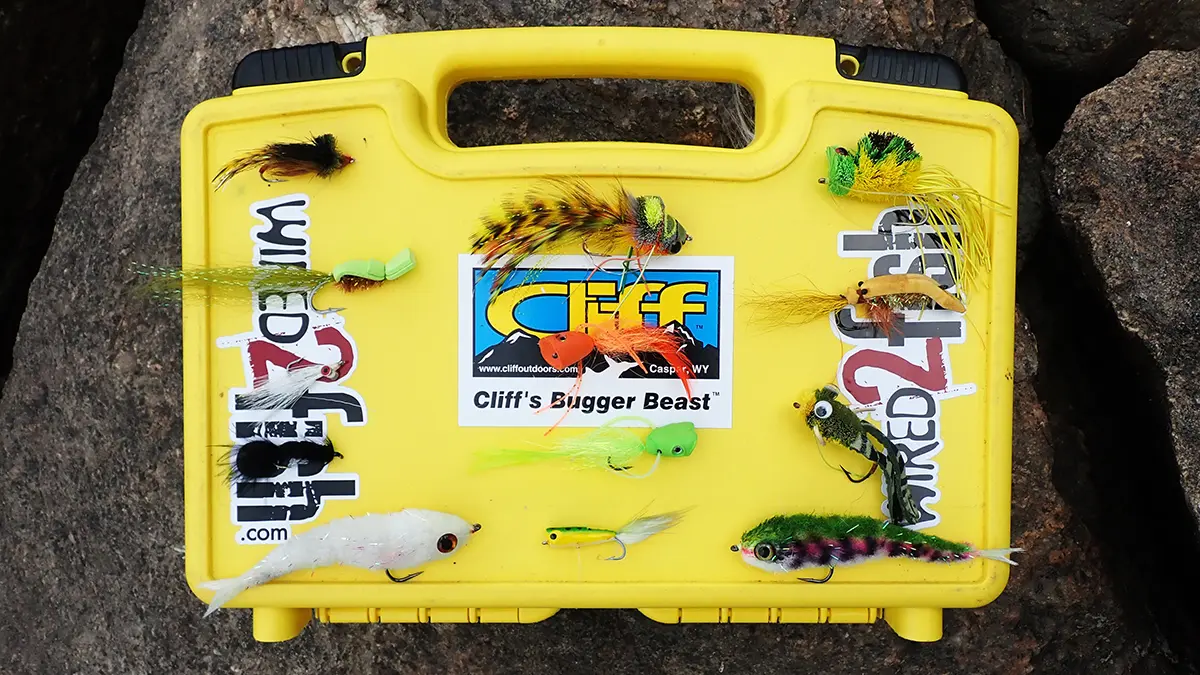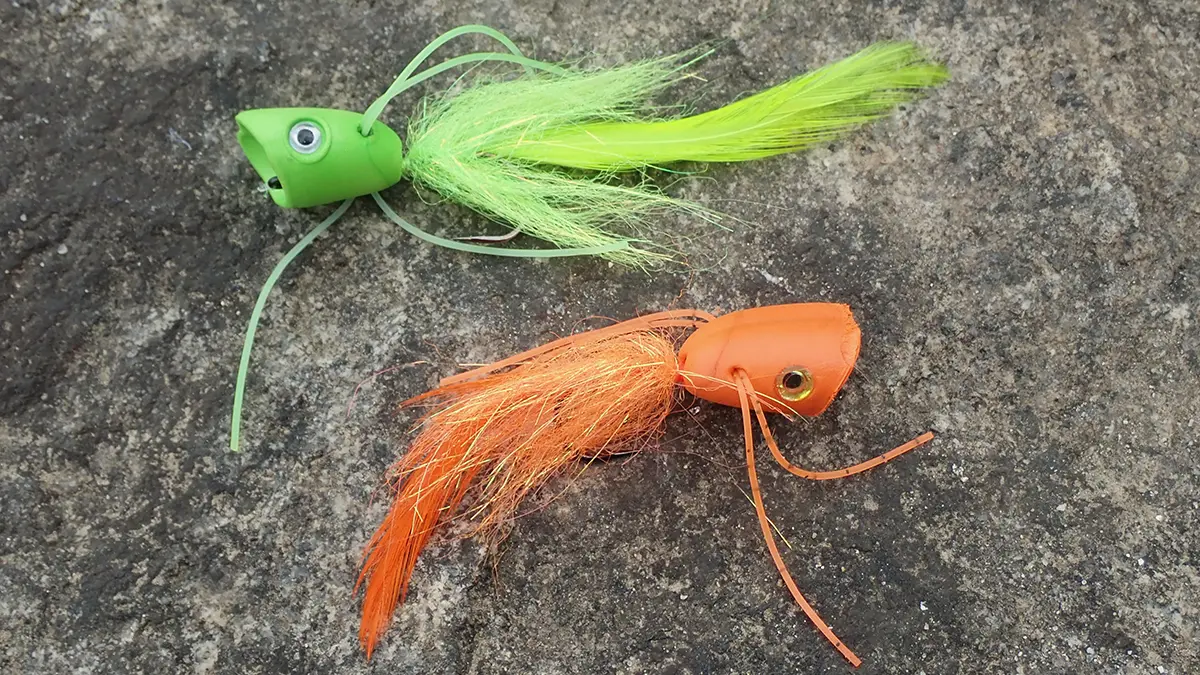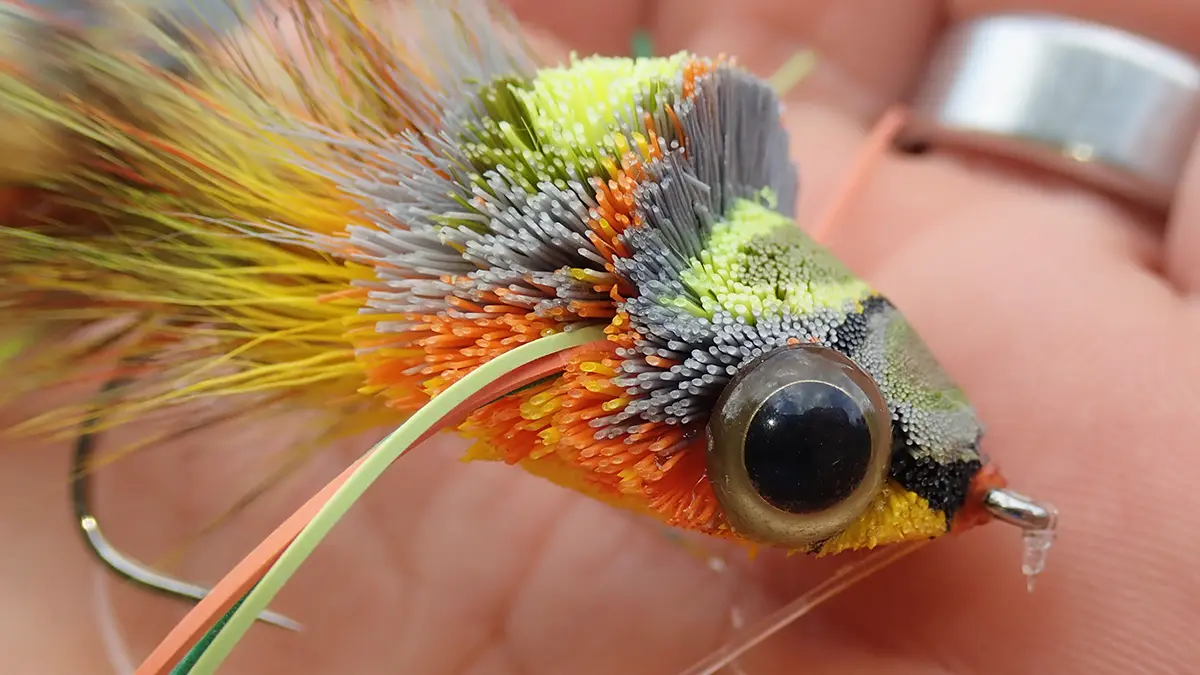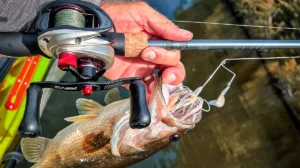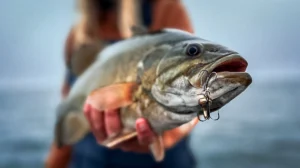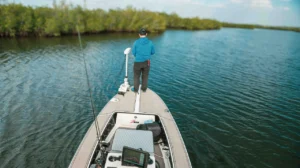I’m just going to admit it: Sometimes when the trout fishing peters out for the summer, I’m relieved to be able to switch to bass. Bass are just fantastic on a fly rod, and fly-fishing brings aspects to the game that fishing with crankbaits and soft plastics cannot, such as a stealthy entry and the ability to float motionless in a lifelike way. Smallmouths and largemouths are less fussy than trout, but they’re not pushovers, and some flies do work better than others. Here are some of the best bass flies that have proven their effectiveness on America’s favorite freshwater game fish.
Best Topwater Flies for Bass: Impossible to Ignore
Catching fish at the surface is a blast, whatever the species. You cast, you wait, you hope, and then you win—fish fooled, right before your eyes. There’s also a practical reason to fish poppers: they attract attention in a way that most subsurface flies don’t. If your underwater fly swims quietly along the east edge of the hole while the bass is looking west, there won’t be any excitement for either of you. It’s impossible not to notice a popper’s burping, splashing commotion at the surface. The bass will see it, or hear it, or feel it in its lateral line, and may well conclude the ruckus is caused by a struggling and vulnerable fish, frog, or rodent—something that must be eaten.
Foam Poppers
Modern poppers are often made of foam, which is fun and easy to work with, but the classics were made of balsa wood. The more contemporary material has the advantage of being more resistant to damage, and usually makes them cheaper to produce. They’re light enough for fly-casting and push plenty of water on the retrieve. Rubber legs and splayed hackle-feather tails are pretty standard and may close the deal by suggesting kicking legs or panicked appendages of some other kind.
The cliched advice is to let your popper sit still after it lands on the water, for as long as you can stand to wait, before starting the popping. I’ve always tried to comply with this rule, although I can’t say for sure that makes a big difference. Set hard once you feel the weight of the fish, not on the initial splash.
Deer Hair Divers
Spun deer hair packed and trimmed deer body hair might just be the perfect material for surface divers. In the hands of a capable tyer, stacks of deer hair in a variety of colors can be spun onto a hook shank, packed into a dense body, and trimmed into a shape that dives on the retrieve, only to slowly bubble back up to the surface is a seductive manner that is usually too much for a bass to resist. The sky’s the limit when it comes to color patterns, and these can be shaped to imitate frogs, baitfish, or even mice scurrying across the water. Perhaps the most famous, and effective, of these is the Dahlberg Diver, though there are countless other varieties that get the job done.
Fishing deer hair divers effectively involves short, fast strips that pull the diver under with a loud PLOOP. Give it enough time to float back up, then a few moments more—this is often when the strike will occur. Set the hook with force once you feel the weight of the fish.
The Gurgler
The Gurgler was originally designed for saltwater fish and was soon categorized as a striped bass fly, but it’s a favorite of freshwater bass fishers too. More of a slider than a true popper, it sits low in the film and makes less noise than a popper with a vertical face, which is probably a more realistic imitation of a struggling bait. It’s also considerably more pleasant to cast due to its aerodynamic shape.
This can be fished fast or slow across the surface. Cast out to a likely spot,, and retrieve based on the forage item you are trying to imitate. Use short, rapid strips to fleeing baitfish or long pulls to mimic frogs lazily plodding along. Use a similar hook set to other surface flies; rearing back once you feel the fish’s heft.
Streamers: Subsurface Bass Fly Patterns
The flies known as streamers are designed specifically to imitate small fish. They play the same role as CrankBaits, jerkbaits, and soft plastics; imitating injured or disoriented bait to goad the bass into biting. They’re usually made of light, translucent natural materials like bucktail or hackle feathers, often with a little flash mixed in. Most have some feature that suggests the bait’s eyes. Unweighted streamers can hover seductively, making little micro-movements from the retrieve or the current. Flies with weighted heads, on the other hand, get down deep quickly and jig on the retrieve, an action bass and so many other species seem helpless to resist.
Lefty’s Deceiver
I’m struck by the genius of this fly’s design. The front half is made of bucktail, tapering to a perfect point at its snout and widening gracefully into the body of the bait. The back half is a clump of hackle feathers that undulate in the water like the waving motion of the tail of a fish. This is another pattern that’s equally at home in fresh and saltwater. They usually range from 3 to 6 inches or so; the small ones cast easily on a 5-weight, while the larger models cast better on an 8.
Clouser Minnow
Yet another salt-fresh crossover, the Clouser earned its fame fooling smallmouths on the Susquehanna River. Its dumbbell eyes provide the diving, jigging action that leads so many fish to make a decision they’ll soon regret. Strip it back hand-over-hand, hop it up and down with sharp pulls and rod lifts, or just let it swing across the current—there’s no wrong way to fish a Clouser.
Game Changer
Lively movement in the water has always been the holy grail for designers of subsurface flies. One way to achieve it is with articulation; usually a joint in the middle of the fly that allows its front and back ends to move independently. Blane Chocklett of Virginia designed a baitfish pattern with multiple articulations that wiggles more realistically in the water than any fly before it. It’s labor-intensive to make, so Game Changers are neither easy to tie nor cheap to buy. They really are in a class of their own. Today, Game Changer is a whole category of flies ranging from insect larva patterns to big streamers for saltwater fish.
Buggers and Other Critters
Maybe they look like crayfish, or shrimp, or large aquatic nymphs – or maybe they just look tasty. Bug-like flies with lots of wiggly parts are always a good choice for bass. This is especially true around rocky river bottoms or downed trees. Rubber legs and wispy feathers make these flies look absolutely alive. And in muted colors like olive, black, and brown, they’re a good choice for pressured bass.
Woolly Bugger
Long ago, some fishing addict noticed that winding a feather onto a fish hook makes its fibers stick out kind of like the legs of a caterpillar. This basic style became the chassis for a number of flies, notably the Woolly Worm, used for bass in the Ozarks and trout in the Rockies. It was Russell Blessing of Pennsylvania who decided to replace the Woolly Worm’s stubby red tail with a big bush of wavy marabou feathers. The new version became the Woolly Bugger and it’s on the Mt. Rushmore of flies. The chubby body, spindly legs and always-moving tail could be mistaken for anything from a crayfish to a shrimp. Add a bead or cone to the front and you have a killer jig.
Crayfish Patterns
In stillwaters and rivers across the country, crawfish make up an important part of the bass diet. There are hundreds, if not thousands, of patterns developed to imitate this bass staple. Some are hyper-realistic, while others are more impressionistic, relying on the illusion of movement to coerce bass to bite. Others offer built-in action, like the Wiggle Craw pictured here, which takes some cues from CrankBaits. Sharp strips get it to dive downward in a tight wiggle thanks to the lip, and the foam construction makes it float upward haplessly.
Tackle for Fishing Bass Flies
Because both the flies and the bass tend to be chunky, fly rods on the heavier side of the freshwater range are best, in sizes 6 through 8. A sinking line can be an advantage on lakes and large rivers where most of the catching takes place well below the surface, but a floating line will suffice in most situations and will also allow the use of surface patterns. Bass aren’t especially leader-shy and they do pull hard, so tippets should be anywhere from 3X for flies with hooks sizes 6 to 2 to as heavy as 0.015 inch for flies from 2/0 to 5/0, which is probably about as big as bass flies go. Leaders don’t usually need to be long; 7 feet is plenty.
Like most fish species, bass are most cooperative early and late in the day, but plenty of action occurs in the afternoon, too, and anglers intrepid enough to fish in the dark may have the best luck of all.
At one time, bass fly-fishers made do with big trout flies or small saltwater patterns. Today, there’s a wealth of patterns designed specifically for bass, and learning which ones work best for you is part of the fun. One of them may even provide your most memorable catch of the year.


